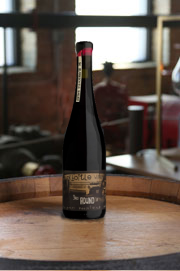- Analysis
- Vineyards
- Vinification and Aging
- Tasting Notes
- 2014 Vintage Notes
2014 3rd Round
Wine of Origin
Western Cape
Varietals
Pinot Noir, Sangiovese, Carignan, Mouvedre, Syrah, and Cinsault
Analysis
Wine Maker: Pieter H. Walser
Alcohol: 14.5%
Total Acidity: NA
pH: NA
Total Production: NA
Owning a farm limits you to the vineyards on your specific farm. I love traveling and experiencing many different areas. I want to make area specific wines, wines that will be ambassadors for areas. I harvest 55 tons from 47 vineyards; 26 different varietals and growing – anything from Fernao Pirez to Cabernet. In the 2015 harvest, I drove 13 000 killometers in 100 days to pick my grapes.
Vineyard-site selection is where all wine begins, and to me personally, one of my most crucial. The graves for this blend came from vineyards across the Western Cape. The Sangiovese came from a vineyard in Stellenbosch. The Carignan, Mourvedre, and Syrah came from some older vineyards in Swartland. The Pinot Noir came from a cooler site in Elgin. While the Cinsaut came a vineyard in Breedekloof, within the Breede River Valley.
A few years ago I was approached by a guy who was supplying wines to Woolworths. He had this project in mind where he wanted to make wines with the Parlotones, a very famous South African rock band. At the time BLANKbottle was still in its infancy (it had a really long infancy, like in 8 years or so…), anyhow, not knowing where I was heading with my career, I agreed to assist them with the project. Goodness, we had a blast! we not only converted the band members into wine’os but also made films, went for these ridiculousy long lunches followed by ridiculously long after parties. We made 3 wines which got its spot on the sought-after Woolworth shelf. That was my 1st round.
A year later, on the back of the previous success, they asked me to, in my own capacity, make a wine exclusive to them. They loved the Spaniard under the BLANKbottle label and wanted something similar. So we sat down for my 2nd Round: A blend of Mourvedre, Grenache, Carignan and Cinsaut followed and was very successful for 3 years. During that time BLANKBOTTLE went through significant growth where I realised what I liked and the direction I wanted to go in life. So in February 2015, Ivan Oertle was on the judging panel for the wine-label design awards, presented by WineMAG. After the competition he approached me with a new concept. He wanted to launch a premium wine range in the top 15 Woolworths stores country wide called “Craft Wine”. You see, craft beer is on the up and they wanted something similar, but in wine. So, on the morning of August 16, 2015, I walked into the cellar and took a iPhone panoramic photo of a very neat winery. Neither Julia, my assistant (who was busy cleaning glasses at that very moment), nor me, at the time, realised that this photo would become a label and that thousands of people will see Julia cleaning glasses in the winery.
In terms of winemaking it is as you can imagine a bit of this and a bit of that. But all components spend 18 months is old French oak, some were whole bunch fermented, some spend a long time on the skins, some less. All in all the wine is an elegant, super enjoyable fresh red blend of STELLENBOSCH Sangiovese, SWARTLAND Carignan and Mourvedre, ELGIN Pinot noir, BREEDEKLOOF Cinsaut and SWARTLAND Syrah.
The 2014 “3rd Round” is a lighter bodied red blend with a silky mouth feel, firm tannins, and a purity of fresh red and black fruits. This wine over delivers across the board. Red raspberry, black cherry, and over ripe strawberry, lead the charge. The wine has a lengthy, elegant finish, and a depth and complexity that continues to evolve as the bottles contents dwindle. This wine would pair very well with any sort of grilled meat featuring savory herbs, but would also make a fantastic cocktailing wine.
An exceptional year, with much higher yields – especially in dryland areas – and the promise of very high quality wines.
Initial vineyard growth was slow due to late cold fronts in August, followed by cool, wet weather at the beginning of the growing season. This led to a high incidence of disease, and rainfall mid-November further hampered effective disease control by creating challenging spraying conditions and limiting access to vineyards. As a result, downy mildew resulted in crop losses early on in the season in some areas. The climate was favorable for flowering thereafter, and good berry set was obtained. However, after the high rainfall mid-November, vigorous growth ensued, requiring extra input to ensure high grape quality and disease prevention via good canopy aeration and sunlight exposure. Ideal dry, moderate conditions reigned during ripening in January and mid-February, after which a warm period accelerated ripening and resulted in great pressure on intakes in some areas. Cooler weather in March enhanced color formation and flavor retention in later red cultivars. Regular rainfall at the end of March delayed ripening again and extended the harvest to mid-April.

